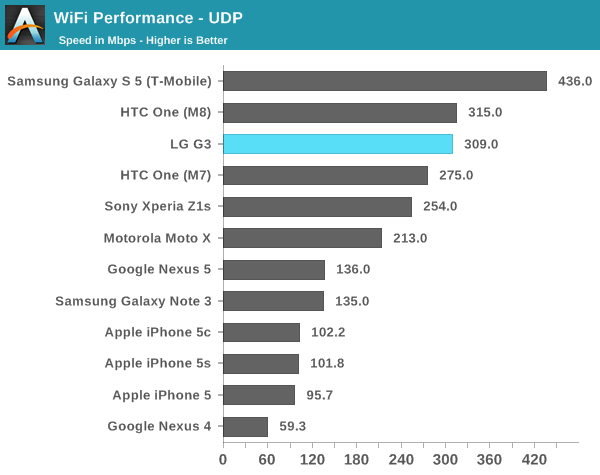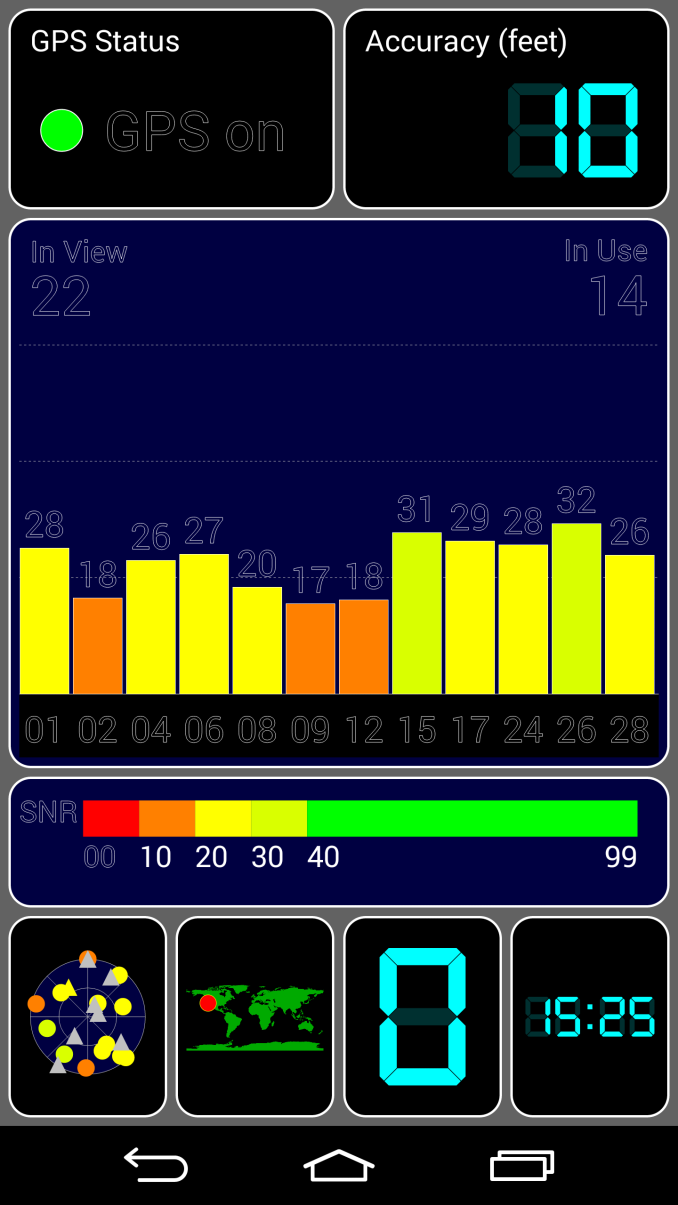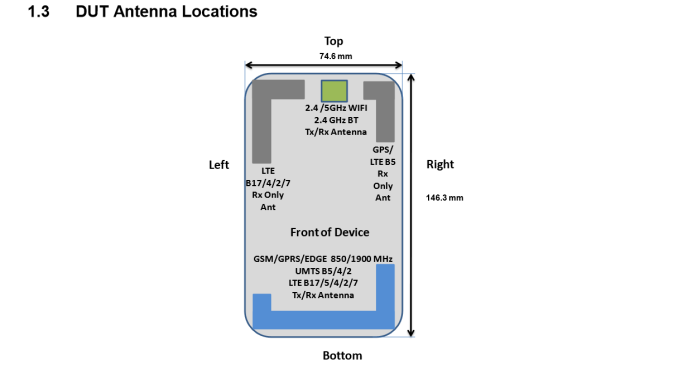The LG G3 Review
by Joshua Ho & Anand Lal Shimpi on July 4, 2014 5:00 AM EST- Posted in
- Smartphones
- LG
- Mobile
- Laptops
- G3
WiFi
These days, most OEMs seem to be using either Qualcomm's WCN3680 or Broadcom's BCM4354, depending upon whether the OEM wants to use a 1x1 or 2x2 antenna configuration. Surprisingly, LG bucks this trend by using Broadcom's BCM4339, a combo WiFi/BT/FM chip that we first saw in smartphones such as the Note 3 and Nexus 5. The WiFi antenna in this case seems to be along the top edge of the phone. It seems that LG has done some work to improve performance on this platform, as we see near parity with the One (M8)'s WCN3680 setup when the Nexus 5 and Note 3 were noticeably worse in performance. I suspect that LG selected this part with the specific goal of maintaining commonality and driving down cost by increasing volume. In this case, there doesn't seem to be any real disadvantage, especially because going to 2x2 hasn't quite doubled transfer speeds in practice.

GNSS
While GNSS quality was once a significant issue in the age of the Galaxy S and HTC Desire, today things couldn't be further from the truth. Almost every smartphone uses the MDM9x25 IP block in one way or another, and this means that GPSOne Gen8B is included as well for GLONASS, GPS, and Beidou support. Overall, accuracy is strong and the time to first lock is extremely fast, even without assistance data. On a cloudy day in San Jose it took around 30 seconds to do a true cold lock without assistance data.
Cellular
For the most part, there's not much new here as this cellular architecture is shared by the One (M8) and Galaxy S5. Namely, the G3 has an MDM9x25 modem, a WTR1625L and WFR1620 transceiver for carrier aggregation, and an Avago power amplifier for the antenna. I didn't notice much in the way of issues with cellular reception or anything else on the G3, although it seems that the SKT variant we were sampled doesn't read AT&T USSD codes correctly. This should be resolved by buying the correct regional variant. The photo below shows general antenna placement for the variants that I've seen, but banding will differ.
Rear Speaker
Unfortunately, I don't yet have the necessary equipment to test speakerphone volume on devices, but subjectively LG has put a solid speaker into the G3. It's still rear-facing, but both volume and quality are good enough to be comparable to the M8. Curiously, rather than an NXP speaker protection IC, LG has gone for a Cirrus Logic solution that identifies itself as the CS35L32. Based upon a quick search on the internet, this appears to be an obsolete part, with not much else in the way of available information.
Misc
While I'm unable to test the wireless charging functionality, I've found that the LG G3 uses IDT's IDTP9025A Qi receiver with support of the Qi 1.1 spec, which improves sensitivity to foreign objects that could heat up the phone. The NXP PN547 NFC chip in the G3 also supports host card emulation, so Google Wallet tap and pay transactions should work without issue. There's also a Maxim MAX17048 fuel gauge in the phone, which means that no battery calibration routine is required, with automatic self-correction of errors in battery charge level. It's also a bit interesting to see that a TI BQ24296 charger chip is used instead of a Qualcomm solution, which means that the Quick Charge protocol isn't supported. It seems that signalling is done via BC 1.2. The G3 uses Qualcomm's Fluence noise cancellation technology for phone calls.












174 Comments
View All Comments
peterfares - Friday, July 4, 2014 - link
I agree. Give me a damn removable battery and SD slot.Stacking it might get it to have slightly more capacity but not that much. Like 5% more. I'd rather have it be removable.
Krysto - Friday, July 4, 2014 - link
Android OEMs short-sighted focus on marketing gimmicks to the detriment of actual performance is infuriating. As you said, LG could've chosen a higher quality 1080p display, that along with the same battery would've also given better battery life and higher performance. But no, instead they chose to chase the "bigger is always better" gimmick.We have a Full HD display in the palm of our hands - what more could we possibly need? They could've chose a 1080p display with a bigger focus on sunlight visibility, or just leave it the same, and focus on improving the camera even more, or making a more solid device.
ZeDestructor - Friday, July 4, 2014 - link
What kills it for me is the 5.5" Size. As someone who did the Xperia Z->Z1->Z2 route (the LCD did improve successively every generation, especially wrt colour gamut), phones are getting more and more unwieldy. If it weren't for the fact that the Z2 is physically narrower than the Z1, I'd have skipped it and waited for the Z2 or Z3 compact.SleepyFE - Friday, July 4, 2014 - link
I still prefer battery life. 480x800 is enough for me. It doesn't distort smaller letters, so i can still read a fully zoomed out web page (if it's not too wide). And you can have a smaller phone (a must since i keep it in my front pocket). I also prefer a bit more space between the screen and the edge. Right now i can't use my phone with one hand as it detects the tips of my fingers when i hold my phone. My grip has to be too lose for my liking.ZeDestructor - Friday, July 4, 2014 - link
480x800 and even 1280x720/1280x800 suck compared to 1080p. It's not just the ability to render, it's the font smoothing that's required. You need extensive smoothing at lower densities, and while it produces something readable (if fatiguing) for Latin-based, Cryllic and most Middle-Eastern and Indial peninsula characters, far-eastern scripts like Japanese or Mandarin render poorly, especially beneath 300ppi.Here's a comparison between 300ppi and 600ppi by JDI in 2012: http://www.j-display.com/english/news/2012/2012060...
SleepyFE - Friday, July 4, 2014 - link
Yeah with 3mm blown up to 2cm. But that's not how zoom work is it? Like you said, the font smoothing solves it and since there is less pixels the GPU consumes less power as well.ZeDestructor - Friday, July 4, 2014 - link
If you've never read Asian characters for any extended period of time, you'll think that font smoothing is enough. Fact is, it's not. With font smoothing, at small sizes, Far-Eastern characters just look like a blurry, gray mess, so people use hand-designed, pixel-perfect bitmap fonts instead.. For an equivalent comparison zoom it out to around 40-50% (because yay 100ppi on most computers :/). The difference in quality matters in person. Not for us, but for other people elsewhere on the planet.SleepyFE - Friday, July 4, 2014 - link
Another problem with the comparison is the size of Asian characters. In the picture they are the same size as latin characters. They write them bigger on paper for a reason. They would be a blob of ink if they were only a few millimeters. They need to use bigger fonts for their characters. Problem solved.ZeDestructor - Saturday, July 5, 2014 - link
On electronic media, Asian characters are sized similarly to Latin characters.fokka - Friday, July 4, 2014 - link
i also prefer battery life, but i think the z1 compact, moto g and moto x are at the sweet spot of resolution for me 720p is nothing over the top anymore and makes for perfectly fine ppi at 4.3-4.7 inches.1080p is great too at 5 inches and upwards, but that's already where diminishing returns kick in heavily.
but 1440p is just stupid with phones you can burn through in 3 hours, if you really want to.